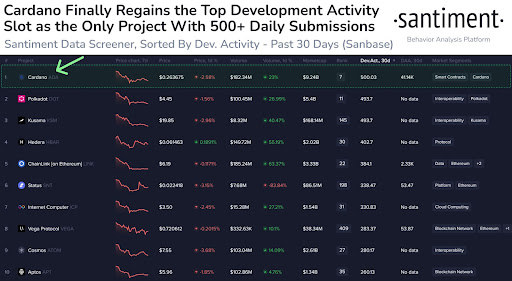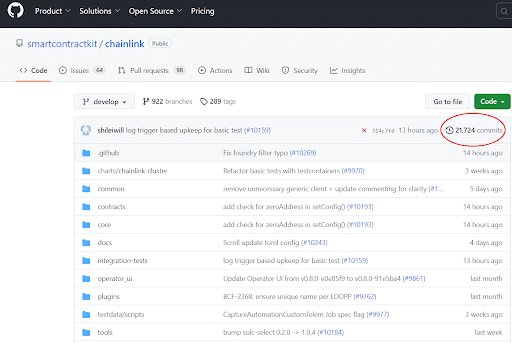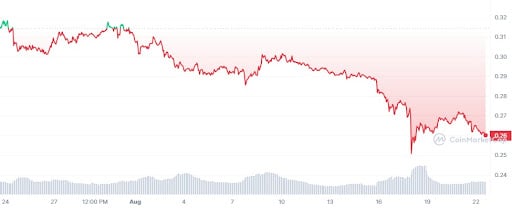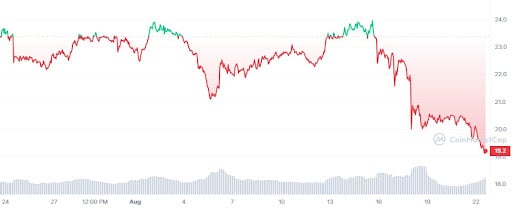The latest data from the Santiment platform show thriving activity on Github by Cardano developers with more than 500 submissions per day: behind the famous smart contract platform are Kusama and Polkadot, which record excellent numbers.
Analyzing the metrics of participation in code development activities can help to understand whether a project is working well for the future or is stalled with work.
However, the crypto assets ADA, KSM, and DOT have reacted poorly over the past 30 days of trading in the markets, not caring about the reported good data
See all the details below.
Cardano leads the ranking of top crypto projects by development activity on Github: Kusama and Polkadot on the podium
Santiment, a crypto platform for on-chain behavior analysis, today highlighted how crypto projects Cardano, Kusama, and Polkadot are experiencing excellent activity from their web3 developers.
In particular, Cardano, a popular platform for creating smart contracts built with the Haskell programming language, has managed to return to 500 daily submissions (30-day average) on the Github repository platform.
Following right behind the project led by decentralized finance pioneer Charles Hoskinson are Kusama and Polkadot, which both score 493 daily applications.
Rounding out the top 10 are various protocols, platforms and networks: moving in order we see Hedera, Chainlink, Status, Internet Computer, Vega Protocol, Cosmos and Aptos.
Studying the trend of interactions on GitHub by the community of the various crypto projects is very useful to see if something is simmering and there are significant developments on the horizon.
If we see declining developer activity, we can infer that insider interest is waning and therefore it might be a good idea to focus one’s time and capital on other cryptocurrencies.
Conversely, a growth in this indicator indicates that there is most likely interest and developers believe in the future of the project in question
Bitcoin and Ethereum currently register activity on Github of 69 and 268 daily “submissions,” respectively.
How to calculate the amount of development activity on Github?
There are several methods for calculating the amount of activity being performed on the Github repository platform for crypto assets such as Cardano, Kusama or Polkadot.
The simplest but also the most fallacious method refers to observing the number of “commits,” which records the modification or addition of one or more files directly on the Github dashboard of the project in question.
However, in this way one can easily run into alteration situations where some scam project artificially pumps up the number of commits or forks the source code of an already started platform to inherit previous activities.
Even in the case of legit crypto assets, such as Kusama, Cardano, Polkadot, or Chainlink, this technique may be inaccurate in classifying the most significant developments.

In contrast, Santiment, which is the platform on which the previous assertions were based, uses a method that relies on the “number of GitHub events” generated by the project organization.
These events include:
- number of code presses
- number of interactions with issues: add/delete/edit comments in issues
- number of pull request interactions: add/delete/edit comments in PRs
- number of github wiki edits
- number of comments on commits
The main advantages of this classification mainly concern the inability to inherit past events via forks in addition to the immutability of the past track record.
Moreover, it is worth mentioning that the activity of the developers does not consist only in the modification of the code itself but also finds its place in secondary (but still very important for the success of the project) activities such as reporting and discussions to the community.
Price analysis for Cardano (ADA), Kusama (KSM) and Polkadot (DOT) crypto assets
Although the developers of Cardano, Polkadot, and Kusama are working excellently with regard to improving their codes, the performance of the ADA, KSM, and DOT crypto assets does not seem to positively reflect the excellent data reported earlier.
The crypto markets unfortunately do not take into account the progress of work on repository platforms and focus mostly on purely speculative issues, at least in the short term.
In the long run, things change, and analysis of this data can come in very handy in understanding what the dominant platforms and protocols of the future will be.
Over the past 30 days Kusama (KSM), Polkadot (DOT) and Cardano (ADA) have posted highly negative performances, all three losing roughly 18% of their value.
In detail Cardano (ADA) fell from $0.31 to the current $0.26 following a sharply bearish trend accelerated during last week’s massive BTC dump.

Same outcome for Pokadot (DOT), which seems to be in slightly worse shape than ADA, with a price drop that has seen its price lose a whole dollar, translating into billions of dollars in losses in market capitalization.
1 month ago DOT was trading at $5.42 while it now trades at $4.42 with bearish prospects in the coming days.

The situation for Kusama is also very similar to that of DOT, where we can catch a glimpse of some remnants of attempted uptrend interrupted brutally by BTC’s downtrend that began on 15 August.
Over the past month, prices for KSM have fallen from the initial $23.39 to the current $19.2. The speculative outlook for all 3 crypto assets is far from reassuring in the short term.







